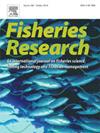阿根廷在西南大西洋易受海龟误捕影响地区的捕鱼活动特征
IF 2.2
2区 农林科学
Q2 FISHERIES
引用次数: 0
摘要
阿根廷北部大陆架的高生物生产力支持了几种渔业,并构成了三种受威胁的海龟物种的食物来源:赤蠵龟、赤蠵龟和赤蠵龟。这项研究首次描述了阿根廷在易受这些物种副渔获物影响地区的捕鱼活动。分析了由国家渔业局提供的渔业统计数据库(2020-2023),以识别和表征船只和渔业,量化捕捞努力量,并分析其在不同区域和季节的变化。大约有240艘不同特性的船只在这些重要地区作业。渔船捕捞努力的差异表明,并非所有渔船对海龟的影响程度相同。捕鱼区和易受影响区域之间的重叠,以及船只数量和登陆吨数表明,长度为6.9-26.9 米的新船队最相关,特别是长度为22.8 米左右的船队。与海龟重叠的渔业主要是海底多物种,特别是使用底拖网和刺网的渔业。这些应被视为今后副渔获物评估的优先事项。由于阿根廷船队缺乏船上观察员和数据收集方面的挑战,这些发现为未来的副渔获物研究提供了重要的指导。捕鱼努力量的高度可变性强调对影响最大的船只进行目标监测,并相应地调整副渔获率计算。由于重叠的捕鱼区属于不同的行政管辖范围,协调努力对于有效监测和养护副渔获物至关重要。本文章由计算机程序翻译,如有差异,请以英文原文为准。
Characterization of Argentina's fishing activity in areas susceptible to sea turtle bycatch in the Southwestern Atlantic
The high biological productivity of the Northern Argentine Continental Shelf supports several fisheries and constitutes a food source for three threatened sea turtle species: Chelonia mydas, Caretta caretta and Dermochelys coriacea. This study characterizes, for the first time, Argentine fishing activity in areas susceptible to bycatch of these species. The fisheries statistics database (2020–2023), provided by the National Fishing Agency, was analyzed to identify and characterize the vessels and fisheries, quantify fishing effort, and analyze its variation across different zones and seasons. Approximately 240 vessels with diverse characteristics operate in these important areas. The variation in fishing effort among vessels suggests that not all vessels have the same level of impact on turtles. The overlap between fishing zones and susceptible areas, along with vessel numbers and landed tons, indicates that fresh fleet vessels 6.9–26.9 m in length are the most relevant, particularly those around 22.8 m. Fisheries overlapping with sea turtles are mainly demersal multi-species, especially those using bottom trawls and gillnets. These should be considered a priority in future bycatch assessments. Due to the lack of on-board observers across the Argentinean fleet and data collection challenges, these findings provide essential guidance for future bycatch studies. The high variability in fishing effort emphasizes targeting monitoring on the most impactful vessels and adapting bycatch rate calculations accordingly. Given that overlapping fishing areas fall under various administrative jurisdictions, coordinated efforts are crucial for effective bycatch monitoring and conservation.
求助全文
通过发布文献求助,成功后即可免费获取论文全文。
去求助
来源期刊

Fisheries Research
农林科学-渔业
CiteScore
4.50
自引率
16.70%
发文量
294
审稿时长
15 weeks
期刊介绍:
This journal provides an international forum for the publication of papers in the areas of fisheries science, fishing technology, fisheries management and relevant socio-economics. The scope covers fisheries in salt, brackish and freshwater systems, and all aspects of associated ecology, environmental aspects of fisheries, and economics. Both theoretical and practical papers are acceptable, including laboratory and field experimental studies relevant to fisheries. Papers on the conservation of exploitable living resources are welcome. Review and Viewpoint articles are also published. As the specified areas inevitably impinge on and interrelate with each other, the approach of the journal is multidisciplinary, and authors are encouraged to emphasise the relevance of their own work to that of other disciplines. The journal is intended for fisheries scientists, biological oceanographers, gear technologists, economists, managers, administrators, policy makers and legislators.
 求助内容:
求助内容: 应助结果提醒方式:
应助结果提醒方式:


